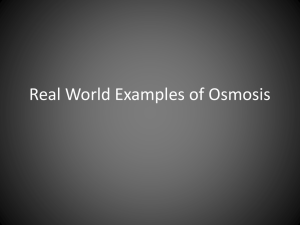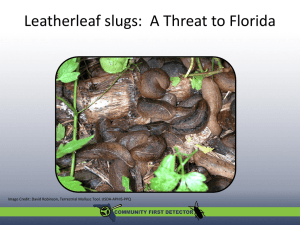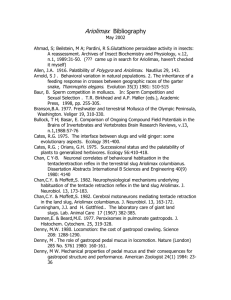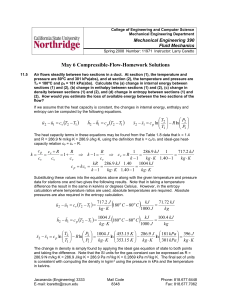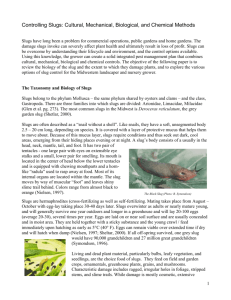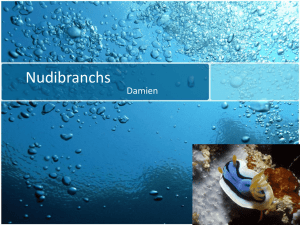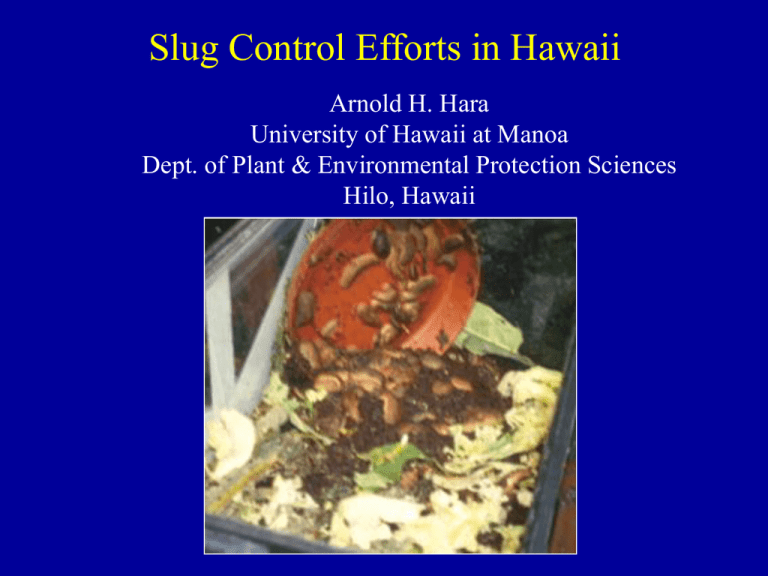
Slug Control Efforts in Hawaii
Arnold H. Hara
University of Hawaii at Manoa
Dept. of Plant & Environmental Protection Sciences
Hilo, Hawaii
Pestiferous Snails and Slugs in Hawaii
Two-striped slug, Veronicella cubensis
Brown slug, Vaginulus plebeius
Tornatellides sp., a
native cone spiral
shell snail on foliage
<1/4 inch in length
Zonitoides arboreus,
an alien flat spiral shell
snail on foliage and
roots of plants. <1/4
inch
Giant African Snail, Achatina fulica
Two-striped slug,
Veronicella cubensis
Brown slug,
Vaginulus plebeius
*These slugs were first reported in Hawaii in 1978-1985.
*
*Extensive damage to ornamental, vegetable and landscape plants.
*High rainfall (133 in per year) encouraged high slug populations.
*No effective natural enemy has been identified.
*Hawaii has a rich native snail fauna.
Endangered Hawaiian Tree Snails
Achatinella sp.
*Victim of forest depletion,
shell collection, canivorous
snails.
*Twenty-two of 41 species
are already extinct.
Biology of Slugs
*Adults are hermaphroditic (possess
both male and female sex organs).
After mating both may lay eggs.
* Egg mass average about 50 eggs,
and hatch in 14-30 days depending
on species and temperature.
*Juveniles reach sexual maturity in
3-5 months and may take 2 years to
fully grown.
*Copper is know to be repellent and
toxic to slugs. Used as a mechanical
barrier in nurseries.
*Slugs are effectively controlled with
slug bait with metaldehyde as the
toxicant (Deadline, Corry’s etc.)
Egg mass
Copper screen between
leg and bench top.
Efficacy of Molluscicides
• Almost all molluscicides available today have
metaldehyde as the active ingredient.
• Formulation and bait attractancy determine
efficacy.
• Major formulation types include:
– Granule (Deadline granules)
– Coated Granule (Durham Granules)
– Pellet (Deadline Bullets, Deadline Mini-Pellets)
– Paste (Deadline 40)
– Liquid (Deadline One Last Meal)
Evaluation of Molluscicides
(with & without simulated rainfall)
Screen
bottom
Each molluscicide evaluated was
applied at the recommended rate to
one sq. ft2 cages, constructed of a
of a wood frame, aluminum screen
bottom, and a Plexiglas cover.
Cage contained potting mix (1” thick),
lettuce and a slug shelter.
Rainfall was simulated daily using
overhead irrigation (500 ml).
At daily intervals, 10 slugs were added
to one of eight cages which was then
covered to prevent further watering.
Mortality assessed 1, 3, and 6 DAT.
Dead slugs - Deadline
Two-striped slug, Veronicella cubensis
Treatment
w/o rainfall
Deadline Granules
(G)
Deadline Bullets
(P)
Deadline OLM
(L)
Deadline 40
(LP)
Snail & Slug AG
(P)
RCO Slug & Snail
(P)
Corry’s Liquid Control (L)
Metaldehyde Methiocarb (CG)
Durham 3.5 Granules
(CG)
Corry’s S/S Insect Killer (P)
Corry’s S/S Insect Killer (L)
Ortho Bug-Geta
(P)
83.5
65.8
29.9
17.7
60.1
44.9
17.5
33.3
28.4
27.4
16.8
41.0
*Subjected to 500 ml of simulated rainfall daily for 8 days.
*Mortality observed 6 days after treatment.
w/ rainfall*
44.3
44.3
39.3
37.7
36.7
33.3
25.7
16.5
8.4
8.3
6.1
3.2
Brown slug, Vaginulus plebeius
Treatment
Deadline OLM
Snail & Slug AG
Deadline 40
Deadline Bullets
RCO Slug & Snail
Corry’s Liquid Control
Deadline Granules
Ortho Bug-Geta
Corry’s S/S Insect Killer
Metaldehyde Methiocarb
Corry’s S/S Insect Killer
Durham 3.5
Durham 7.5
Ortho Bug-Geta Plus
w/o rainfall
(L)
(P)
(LP)
(P)
(P)
(L)
(G)
(P)
(P)
(G)
(L)
(CG)
(CG)
(P)
40.5
62.4
18.0
76.3
55.1
13.6
81.2
57.5
38.1
60.3
6.8
47.2
47.9
34.6
w/ rainfall*
47.8
47.5
46.6
45.6
42.2
37.4
32.1
23.9
21.5
21.0
17.6
15.6
14.8
10.1
*Subjected to 500 ml of simulated rainfall daily for 8 days; Mortality 6 DAT.
Deadline Bullets
Pelleted Formulation
Brown slug
Mortality
(arcsine)
55
50
45
40
35
30
Y = 52.4 – 2.2x
r2 = 0.8; P = 0.0051
1
0 DAT
2
3
4
5
6
Days after treatment
1 DAT
3 DAT
5 DAT
7
8
7 DAT
Subjected to
simulated rainfall
of 500 ml for 8
Days.
Pellets crumbled
and deteriorated
after initial swelling
with moisture.
4% metaldehyde
Deadline 40
Liquid Paste Formulation
Brown slug
Mortality
(arcsine)
55
50
45
40
35
30
25
Y = 32.1 – 2.3x
r2 = 0.6; P = 0.0263
1
Subjected to
simulated rainfall
of 500 ml for 8
Days.
0 DAT
2
3
4
5
6
Days after treatment
1 DAT
3 DAT
5 DAT
7
7 DAT
8
Liquid and liquid
paste formulations
diffused with rainfall
increasing effectiveness.
4% metaldehyde
Moldy Slug Bait
• Mold development is a problem
in areas with high rainfall/humidity.
• Liquid and paste formulations were more
resistant to mold development than pelleted,
granule or coated granule formulations.
Advantages and disadvantages
Paste and Liquid formulations
+ Increase in effectiveness with rainfall
+ Resistant to mold development
– Poor initial kill
– Application labor intensive
Pelleted formulations
+ High initial kill
+ Easy broadcast application with good coverage
– Decrease in effectiveness with rainfall
– Very susceptible to mold development
Efficacy of Other Snail and Slug Products
*Methiocarb – also effective western flower thrips,
aphids, mites, bird repellent
Mesurol Pro 2% bait- Gowan
Mesurol 75-W 75% spray – Gowan
*Iron Phosphate – fertilizer ingredient from Germany
Lawn and Garden Products, Inc.
Sluggo Bait 1% (Monterey)
Worry Free Slug and Snail Bait 1%
*Metaldehyde –most common molluscicide
Deadline M-Ps (minipellets) 4%
Efficacy of Slug & Snail Baits
percent mortality
(No simulated rainfall)
80
70
60
50
40
30
20
10
0
(Two-striped slug)
Untreated
Mesurol Pro
Iron
Phosphate
Deadline M-P
8 days after treatment
(Rate for all products at
1.0 lb per 1000 sq. ft)
What Killed This Slug?
Untreated
Treated
Garlic!
ECOguard
*Commercial garlic based pesticide developed by in United
Kingdom by ECOspray Ltd.
*Encouraging results in southern Spain for whitefly control in
greenhouse crops.
Promising Products for Slug Control???
*Garlic
a.i. = allicin, effective repellent
2.5 to 5% solution
*Ureaformaldehyde
a nitrogen fertilizer formulated as a pellet.
6% solution
*Cinnnamamide
a cinnamic acid derivative. antifeedant;
repellent
1% solution
From Schuder et al. 2003. Barriers, repellents and antifeedants
for snail and slug control. Crop Protection 22: 1033-1038.
Copper screen barriers
used at a certified nursery
Copper barrier
Effectiveness of Barriers
Number of slugs
V. plebeius
Copper
1.7 b
Fiberglass*
5.3 b
Aluminum
11.7 ab
Paper board 23.0 a
V. cubensis
3.0 b
4.3 b
19.7 a
26.3 a
*Effectiveness of fiberglass was due to the
collapse of the screen with the weight of
the foraging slug.
Copper Hydroxide against Slugs
*Copper hydroxide [Cu(OH)2] is usually used a fungicide
(Kocide; Champ).
*Formulated as a root growth regulator by incorporating the
copper hydroxide into latex paint on the inner surface of
pots, grow bags & groundcovers.
*Inhibits root development, prevents root-bounding and
promotes fibrous root growth.
*Also provides weed control.
*Discovered to be highly effective in repelling slugs.
*For more information on Spinout (Griffin Corp.) go to:
http://www.nurserysupplies.com/products/products.htm
Without
Spinout
With
Spinout
Liquid Flowable
A.I.
Copper Hydroxide* 7.1%
Inert
92.9%
*Metallic copper equivalent 4.6%
Spinout on root mealybugs and palm rooting.
Spinout
Untreated
*Root matting on bottom of pot increased root mealybug infestations.
*Spinout (copper hydroxide) significantly prevented root matting, therefore
minimizing root mealybug infestations.
Control Strategies for Slugs
*PHYSICAL -
copper barriers.
*CHEMICAL -
baits, sprays (Slugfest), copper hydroxide,
garlic.
*CULTURAL -
sanitation; remove rotting leaves.
*MECHANICAL- harvest every morning with a fork or
chopsticks.
*BIOLOGICAL - predacious snail, Euglandina; flatworms,
nematodes, but these will also affect
native snails.
Acknowledgements
For technical assistance:
Benjamin Hu
Christopher Jacobsen
Trent Hata
Julie Yogi-Chun
For financial support:
Amvac
GemChem
Griffin
Lonza
Meerkat Environmental
OR-CAL Chemical
Pace International
United Horticultural Supply



